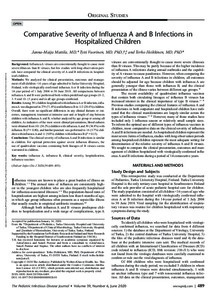Comparative Severity of Influenza A and B Infections in Hospitalized Children
Heikkinen Terho; Vuorinen Tytti; Mattila Janna-Maija
Comparative Severity of Influenza A and B Infections in Hospitalized Children
Heikkinen Terho
Vuorinen Tytti
Mattila Janna-Maija
LIPPINCOTT WILLIAMS & WILKINS
Julkaisun pysyvä osoite on:
https://urn.fi/URN:NBN:fi-fe2021042826816
https://urn.fi/URN:NBN:fi-fe2021042826816
Tiivistelmä
Background:Influenza A viruses are conventionally thought to cause more severe illnesses than B viruses, but few studies with long observation periods have compared the clinical severity of A and B infections in hospitalized children.Methods:We analyzed the clinical presentation, outcomes and management of all children <16 years of age admitted to Turku University Hospital, Finland, with virologically confirmed influenza A or B infection during the 14-year period of 1 July 2004 to 30 June 2018. All comparisons between influenza A and B were performed both within predefined age groups (0-2, 3-9 and 10-15 years) and in all age groups combined.Results:Among 391 children hospitalized with influenza A or B infection, influenza A was diagnosed in 279 (71.4%) and influenza B in 112 (28.6%) children. Overall, there were no significant differences in any clinical features or outcomes, management, treatment at intensive care unit or length of stay between children with influenza A and B, whether analyzed by age group or among all children. As indicators of the most severe clinical presentations, blood cultures were obtained from 101 (36.2%) children with influenza A and 39 (34.8%) with influenza B (P = 0.80), and lumbar puncture was performed to 16 (5.7%) children with influenza A and 11 (9.8%) children with influenza B (P = 0.15).Conclusions:The clinical severity of influenza A and B infections is similar in children. For optimal protection against severe influenza illnesses, the use of quadrivalent vaccines containing both lineages of B viruses seems warranted in children.
Kokoelmat
- Rinnakkaistallenteet [19207]
